Your browser does not fully support modern features. Please upgrade for a smoother experience.
Please note this is an old version of this entry, which may differ significantly from the current revision.
Subjects:
Instruments & Instrumentation
A smart helmet is a wearable device that has attracted attention in various fields, especially in applied sciences,
- wearable device
- smart helmet
- sensor
- microcontroller
- wireless communication technology
1. Introduction
A wearable (electronic) device is a smart electronic device that can be planted on the body or worn with accessories. Since Google recently launched its head-mounted display, wearable devices have garnered a significant amount of attention [1]. Wearable devices have been able to take an important position in the home appliance market in a short period and are considered a new means of meeting the requirements of many industries. For example, the construction industry has studied the use of wearable devices in the workplace for health and safety management by close detection and physiological monitoring of construction workers [2]. The logistics industry has begun using wearable barcode scanner gloves to simplify work that does not involve hand use [3]. Some insurance companies encourage healthy eating habits and use wearable devices to improve the health of corporate workers [4].
There are different types of smart wearable devices, such as helmets, watches, glasses, contact lenses, textiles, fabrics, headbands, beanies, caps, rings, bracelets, and earrings [5]. Among these, this study focused on smart helmets. Smart helmets include multiple electronic devices and sensors that help users gather real-time data and assist them in reducing operational risks and improving safety in the long run. The global smart helmet market size was valued at USD 372.4 million in 2018 and is expected to expand at a compound annual growth rate of 18.6% from 2019 to 2025 [6].
Research on smart helmet applications is being conducted in various fields to improve safety and efficiency of motorcyclists [7] and workers [8,9]. For example, Singh et al. [7] studied the application of smart helmets to detect portholes and collect air quality data on roads. Wang et al. [8] detected stair fall by analyzing changes in weight support and pressure center using a smart helmet, and Mohammed et al. [9] used smart helmets to prevent the spread of coronavirus by measuring the body temperature and personal information of pedestrians. Like some of the examples mentioned earlier, many studies related to the development and application of smart helmets have been reported in the literature [10,11,12,13,14,15,16,17,18,19,20,21,22,23,24,25,26,27,28,29,30,31,32,33,34,35,36,37,38,39,40,41,42,43,44,45,46,47,48,49,50,51,52,53,54,55,56,57,58,59,60,61,62,63,64,65,66,67,68,69,70,71,72,73,74,75,76,77,78,79,80,81,82,83,84,85,86,87,88,89,90,91,92,93,94,95,96,97,98,99,100,101,102,103,104,105,106,107,108,109]; however, no systematic review has been conducted to analyze the current status and trends of smart helmet research.
The purpose of this study was to review the current status and trends of smart helmet research systematically. The current status of smart helmet research by year and application field were investigated by analyzing 103 academic research articles published in the past 11 years (2009–2020). The types of sensors, microcontrollers, and wireless communication technology were analyzed to identify the trends in smart helmet studies.
2. Results
2.1. Current Status of Publications Related to Smart Helmet Research by Year and Source
The number of publications on smart helmets during the past 11 years is shown in Figure 2. In the first seven years (2009–2015), there were limited articles, with an average of 1.28 articles per year. In the next two years (2016 and 2017), the average number of publications increased to 8.5. In 2018, the number of publications more than doubled from the previous year’s average, surging to 21 publications. In 2019, there were 27 publications, and, in 2020, the number of publications was 29, making it the highest number for a year overall. The average number of publications in the last three years (2018–2020) was 25.6, which is nearly three times higher than the average number of publications in 2016 and 2017. Therefore, research on smart helmets has been extremely active recently. Additionally, the sources of publications were academic journals (55.3%) and conference proceedings (44.7%).
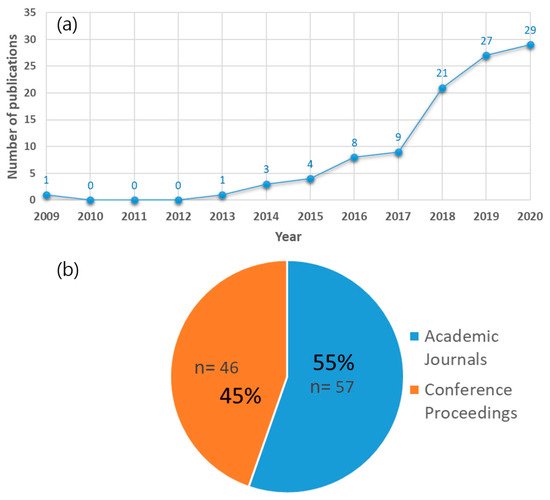
Figure 2. Number of publications related to smart helmet research by (a) year and (b) source of publications.
2.2. Application Fields of Smart Helmet Research
The current status of smart helmet studies in each application field was analyzed to determine which fields were studying and utilizing smart helmets the most. The smart helmet applications were organized in two stages to observe the classification at a glance. In the first stage, the studies were classified into two categories (i.e., motorcyclists and workers) according to users of smart helmets. In the second stage, detailed application fields were added below the first stage, as shown in Figure 3. Figure 4 shows the cumulative number of publications on smart helmets during the past 11 years in the first stage of the classification criteria. As shown, studies on smart helmets for motorcyclists and workers have been increasing every year; however, the rate of increase is relatively faster for motorcyclists. This indicates that research on smart helmets for workers must be accelerated.

Figure 3. Classification of application fields in smart helmet studies.

Figure 4. Cumulative number of publications by year in bike, occupational safety, disaster prevention, and medicine fields.
The applications of smart helmets for motorcyclists consist of 81 studies that account for the largest number of publications [7,10,11,12,13,14,15,16,17,18,19,20,21,22,23,24,25,26,27,28,29,30,31,32,33,34,35,36,37,38,39,40,41,42,43,44,45,46,47,48,49,50,51,52,53,54,55,56,57,58,59,60,61,62,63,64,65,66,67,68,69,70,71,72,73,74,75,76,77,78,79,80]. These applications can be classified into four subcategories: start control, accident prevention, rescue request, and convenience improvement. Some studies fall under more than one subcategory when the developed smart helmet is used for various purposes by motorcyclists. Figure 5 shows the percentage of studies according to the subcategory. Note that most smart helmets for motorcyclists have been developed for the start control of motorcycles (42.3%) and rescue requests in the case of an accident (39.2%).
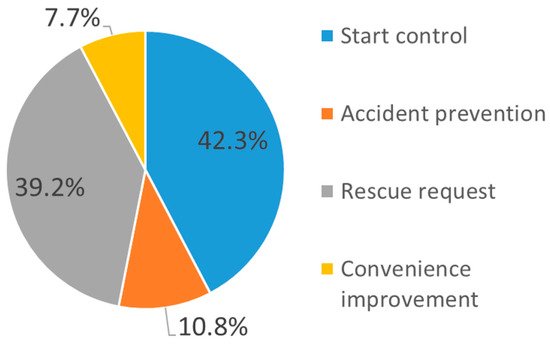
Figure 5. Percentage of smart helmet studies for motorcyclists by sub-category.
Table 2 summarizes the smart helmet applications reported in 81 studies for start control, accident prevention, rescue requests, and convenience improvement of motorcyclists. For the start control, the smart helmet checks whether the motorcyclist is wearing the helmet and for alcohol consumption. If any of the conditions are not met, the smart helmet controls the motorcycle to not start. For accident prevention, smart helmets are responsible for detecting drowsiness, speed and blinking, and providing warning alerts to prevent accidents. In the rescue request, the smart helmets detect a traffic accident and make a rescue request through text or phone calls in the event of an accident. Finally, for improving convenience of motorcyclists, the smart helmet provides them with several functions, including music play, phone calls, audio, and navigation.
Table 2. Summary of smart helmet applications for start control, accident prevention, rescue request, and convenience improvement of motorcyclists (MCU: modular concept unit).
For example, in this category, Kanimozhi et al. [49] developed a smart helmet using a single board-based microcontroller (Arduino) with several sensors for detecting alcohol gas (MQ3) and heart pulse of motorcyclists. The radio frequency (RF) module was used to transmit and/or receive radio signals between the smart helmet and motorcycle. The data were stored in a local storage medium because the helmet did not provide a function to share the data that it monitored with other users. Uniyal et al. [31] developed a smart helmet using the Arduino board, RF transmitter, and sensors for detecting helmet wear, speed, accident, and location. The smart helmet collects and records speeding data of the bike and provides a risk warning when the bike exceeds the speed limit.
A total of 22 academic papers that deal with the applications of smart helmets for workers were published during the past 11 years [8,9,90,91,92,93,94,95,96,97,98,99,100,101,102,103,104,105,106,107,108,109] and are summarized in Table 3. The application fields include mining, construction, petrochemistry, disaster prevention, and medical treatment. Figure 6 shows the percentage of smart helmet studies conducted in each application field.
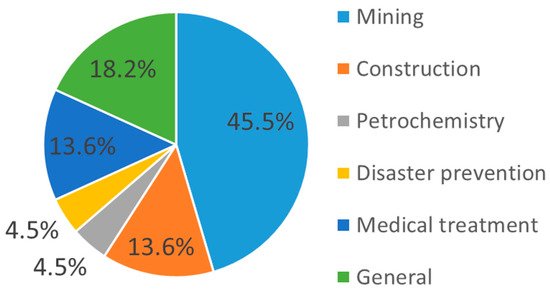
Figure 6. Percentage of smart helmet studies for workers by sub-category.
Table 3. Summary of smart helmet applications for workers in the fields of mining, construction, petrochemistry, disaster prevention, medical treatment, etc.
In the mining industry, 10 studies were performed on a smart helmet that detects harmful gases, such as carbon monoxide (CO) and methane (CH4), and guarantees the safety of workers through rescue requests in the case of a dangerous situation [90,91,92,93,94,95,96,97,98,99]. Three studies have been reported in the construction industry, where smart helmets were primarily used to detect workplace hazards and provide risk alarms to construction workers [8,100,101]. For example, a safety helmet with gravity and head movement sensors was used at the construction site to detect a falling worker and activate emergency rescue requests [8]. Four studies on smart helmets were conducted to support voice communication between workers and warn them by detecting injuries in general manufacturing sites [102,103,104,105]. A smart helmet that ensures the safety of workers by warning the occurrence of harmful gas leaks was developed in the petrochemical industry [106].
Three studies [9,107,108] on smart helmets were found in the medical field to improve the work efficiency of medical staff and ensure the safety of patients. In this application, a smart helmet worn by the medical staff was used to detect body temperature and brain waves in emergency situations [9,107]. A smart helmet was developed for medical staff to detect the body temperature of a pedestrian in real time. It was used to prevent coronavirus by warning them through an alarm when discovering a high-temperature pedestrian. Additionally, a study developed a smart helmet to prevent elderly patients lying in bed from falling [108]. One study reported in the literature dealt with a smart helmet for disaster prevention [109]. In this study, the smart helmet was used to support rescue workers at disaster sites.
2.3. Sensors Used for Smart Helmet Applications
Various sensors are attached to a smart helmet based on the application field and purpose. Table 4 shows the types of sensors used in smart helmet studies. The sensors can be broadly classified into three types: human health, environment, and machine monitoring. The cumulative number of sensor types used in smart helmet studies by year is illustrated in Figure 7a. The use of sensors to monitor human health is increasing every year. The frequency of use of environmental monitoring sensors has also increased in recent years. The percentages of sensor uses for each sensor type are shown in Figure 7b–d. For human health monitoring, the accident detection sensor accounts for 32%, followed by the helmet wear detection sensor and alcohol detection sensor with 30% and 27%, respectively. In the case of environmental monitoring, sensors for harmful gas detection, video shooting, and temperature detection each account for 23%. For the machine monitoring, the speed detection sensor occupies 70% and is the most used.

Figure 7. Trend of sensor uses in smart helmet studies. (a) Cumulative number of uses of sensor types according to year. Usage percentage of sensors for (b) human health monitoring, (c) environmental monitoring, and (d) machine monitoring.
Table 4. Types of sensor depending on the purpose used in smart helmet studies.
Types of sensor depending on the purpose used in smart helmet studies.
| Human Health Monitoring | Environmental Monitoring | Machine Monitoring |
|---|---|---|
| - Accident detection (50 papers) - Helmet wear detection (46 paper) - Alcohol detection (42 papers) - Drowsiness detection (6 papers) - Brainwave detection (4 papers) - Heart rate detection (4 papers) - Head motion detection (3 papers) |
- Harmful gas detection (11 papers) - Video shooting (11 papers) - Temperature detection (11 papers) - Humidity detection (7 papers) - Brightness detection (3 papers) - Barometric pressure detection (2 papers) - Fire detection (2 papers) - Pothole detection (1 papers) |
- Speed detection (7 papers) - Proximity warning (2 papers) - Fuel level detection (1 papers) |
2.4. Types of Microcontroller Used in Smart Helmets
Different types of microcontroller have been used to develop smart helmets. By analyzing 103 articles, this study classified the microcontrollers into four categories.
- -
-
Chip modular concept unit (MCU): a single computer chip designed for embedded applications (e.g., PIC 18F8720) [110]
- -
-
Single-board MCU: a microcontroller built onto a single printed circuit board (e.g., Arduino) [111]
- -
-
Single-board computer: a complete computer built on a single circuit board, with microprocessor(s), memory, input/output, and other features required for a functional computer (e.g., Raspberry Pi) [112]
- -
-
Smart device: an electronic device, generally connected to other devices or networks by means of different wireless protocols that can operate to some extent interactively and autonomously (e.g., smartphone) [113]
The number of studies that used each of the four types is presented in Figure 8. Among the 103 articles analyzed in this study, the single-board MCU was the most used (56 studies), followed by the chip MCU (28 studies). The number of single-board computers and smart devices used was relatively small (11 and 8 articles, respectively). The use of single-board MCUs has increased rapidly since 2016. Although there have not been many uses of single-board computers so far, their use for smart helmets has increased since 2017. The use of smart devices has been minimal, which is believed to be because of the relatively high cost compared with other devices.

Figure 8. Cumulative number of microcontrollers used in smart helmet studies by year.
Figure 9 shows the use of sensors according to the type of microcontroller in smart helmet studies. Accident, helmet wear, and alcohol detection sensors have been frequently used with the chip MCU and single-board MCU. As shown in Figure 7, the uses of accident, helmet wear, and alcohol detection sensors make up a large part of smart helmet applications. Therefore, it is judged that the uses of chip MCU and single-board MCU were rapidly increased due to the increased development of smart helmets for accident, helmet wear, and alcohol detections. In the case of using a sensor that processes a large amount of data such as video shooting, it can be seen that a single-board computer or a smart device is being used. If the use of sensors based on images or videos increases in smart helmet studies, the single-board computers or smart devices are expected to be used more as microcontrollers.
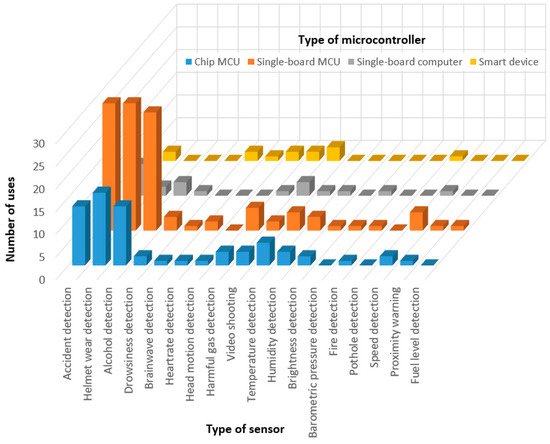
Figure 9. Number of uses by sensor and microcontroller types in smart helmet studies.
3.5. Types of Wireless Communication Technology Used in Smart Helmet Studies
The data obtained from smart helmets can be transmitted to other smart devices or cloud servers using several wireless communication technologies. Of the 103 articles, 88 reported studies that used wireless communication technology, such as RF, Bluetooth, Wi-Fi, and Zigbee for this purpose, whereas the remaining did not. Figure 10 shows the cumulative number of uses of wireless communication technology by year for sharing data from smart helmets. According to the analysis results, RF and Bluetooth were the most commonly used, and the number of uses has been increasing rapidly since 2015. Zigbee has been used for the longest time; however, its usage has not increased significantly until recently.

Figure 10. Cumulative number of wireless communication technologies used in smart helmet studies by year.
The reason why RF and Bluetooth are used frequently is related to the microcontroller used in smart helmet applications. Until now, the chip MCU and single-board MCU have been mainly used for smart helmet development, and these two types of microcontrollers often use RF and Bluetooth as shown in Figure 11. In the future, as the use of single-board computers increases, the frequency of use of Wi-Fi is expected to increase. In addition, the uses of Bluetooth and Wi-Fi may increase when the use of smart devices increases in smart helmet studies.
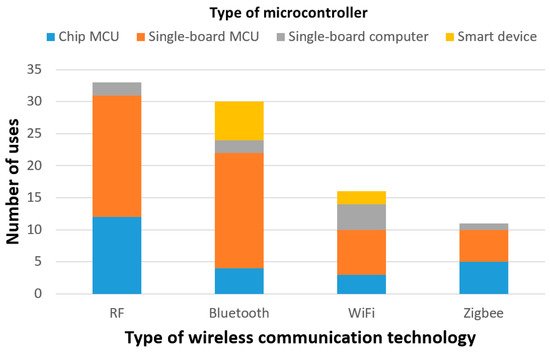
Figure 11. Number of uses by wireless communication technology and microcontroller types in smart helmet studies.
This entry is adapted from the peer-reviewed paper 10.3390/app11115039
This entry is offline, you can click here to edit this entry!
